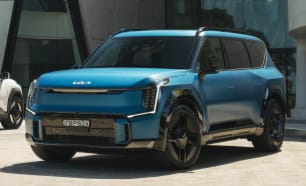Cars from Chinese brands often fall short of expectations when it comes to the drive experience, but the Tiggo 8 Pro Max moves everything in the right direction, and importantly it doesn’t add any deal-breaking characteristics along the way.
Visibility is great out of the cabin, with large windows all-round. The wing mirrors are great, but the centre rear-vision mirror is a quirky piece with a wide viewing angle. In a way this is great for parents, because with one glance you can see both out the rear of the vehicle and the rear seats to keep an eye on kids, but it does mess with your depth perception a bit.
On multiple occasions I felt like the car behind was tailgating, only to peer in the side mirrors to find that it was actually quite far back. Odd!
The steering is very light, and a bit disconnected as a result. While this sounds like a negative, I actually think suburban buyers who often negotiate with shopping centre parking lots, apartment towers, and school drop-offs will love it. It makes a big SUV feel really easy to steer and position.
Sure, it feels a bit doughy out on the open road, meaning it's hardly a confident corner-carver, but that’s not really the point of this car.
The engine on the other hand has loads of poke. Power of 180kW sounds like a lot because it is (once upon a time not so long ago this was well into V6 territory) and actually for the front-wheel-drive versions it might be a little bit too much power. It will readily spin the front wheels with slightly too much throttle input, which brings us nicely to the dual-clutch automatic which is responsible for communicating that power to the ground.
Dual clutches rightly raise a bit of a red flag for some because they can be particularly jerky from a standstill and have some pretty questionable gear shifts once you’re rolling. For the most part though, the Tiggo 8’s dual-clutch unit is pretty good. The brand stressed that it had done significant software tuning to this transmission to try to iron out nasty characteristics, and while it's still occasionally caught off-guard, I’ve certainly driven worse. It will occasionally produce a bucking feeling rather than a full second of lag like some rivals, but its enthusiasm to deliver power to the ground quickly gives the front-drive versions that slightly skittish feel.
It is one of those rare occasions when it’s worth splashing for the all-wheel drive. I found the Ultimate to be much more sure-footed and confident on the road, able to handle the engine’s relatively mountainous torque with ease.
On the open road I was impressed by the Tiggo 8’s level of refinement. The amount of sound entering the cabin in both variants was low, with minimal tyre roar or wind noise. Thuds from the suspension and roar from the engine under load were also pleasingly distant, even at freeway speeds.
When it comes to the ride it’s built to a certain cadence. It’s soft and comfortable, matching the semi-luxurious cabin feel nicely, but it can be a bit springy and lose a bit of body control over undulations and corrugations. Again, it’s not exactly an athlete, but then for most people, it won’t have to be.
Importantly, it filters out sharper bumps like potholes, road imperfections, and speed bumps with relative ease. It’s even better in the 2WD versions thanks to larger tyres and smaller alloy wheels.
Mercifully, the active safety systems don’t intrude on the driving experience either. Chery has apparently learned some hard lessons after the feedback it received on the overbearing lane assist equipment on the smaller Omoda 5, and applied those learnings here in the Tiggo 8.
The lane systems are still there, but they only intervene when they really have to, while warning chimes from things like the traffic sign recognition, blind spot monitoring, and driver attention alert are, at worst, background. It’s a good thing too because of all the systems, the driver attention alert is the one that triggers most often as you look away from the road to adjust the touch-based climate systems.
Where does that leave us? Actually pretty impressed. The Tiggo 8 Pro Max might not have the balancing act between ride quality and performance quite as well tuned as some of its Japanese and Korean rivals, but this is a comfortable, quiet, and refined SUV that, importantly, feels very normal. There’s no deal-breaking safety bugs, or a terrible transmission or frustrating software that takes away from the experience. Chery is learning, and it’s learning fast.























.png)







.png)


.png)

.png)

.png)


.png)

.png)

.png)
.png)
.png)



.png)


.png)





.png)












































.png)
.png)













.png)

























 copy.png)








.png)











.png)

.png)


.png)












.png)


.png)








